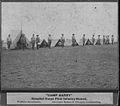
During the American Civil War, the United States Army, the land force that fought to preserve the collective Union of the states, was often referred to as the Union army, the federal army, or the northern army. It proved essential to the restoration and preservation of the United States as a working, viable republic.

Dr. Joseph Lovell was the 8th Surgeon General of the United States Army,,

The Army Medical Department of the U.S. Army (AMEDD), formerly known as the Army Medical Service (AMS), encompasses the Army's six medical Special Branches. It was established as the "Army Hospital" in July 1775 to coordinate the medical care required by the Continental Army during the Revolutionary War. The AMEDD is led by the Surgeon General of the U.S. Army, a lieutenant general.

Albert Vander Veer was a pioneering American surgeon, credited with performing the first thyroidectomy.

East Potomac Park is a park located on a man-made island in the Potomac River in Washington, D.C., United States. The island is between the Washington Channel and the Potomac River, and on it the park lies southeast of the Jefferson Memorial and the 14th Street Bridge. Amenities in East Potomac Park include the East Potomac Park Golf Course, a miniature golf course, a public swimming pool, tennis courts, and several athletic fields. The park is a popular spot for fishing, and cyclists, walkers, inline skaters, and runners heavily use the park's roads and paths. A portion of Ohio Drive SW runs along the perimeter of the park.
The 12th Wisconsin Infantry Regiment was a volunteer infantry regiment that served in the Union Army during the American Civil War. They served primarily in the western theatre of the war, participating in battles and campaigns including the Siege of Vicksburg, the Jackson expedition, the Atlanta campaign, and Sherman's March to the Sea.

USAT Thomas was a United States Army transport ship purchased on 26 July 1898 for Spanish–American War service. Thomas served with the Army Transport Service (ATS) until retired in 1929.

The surgeon general of the Navy (SGN) is the most senior commissioned officer of the Medical Corps of the United States Navy and is the principal advisor to the United States Secretary of the Navy, Chief of Naval Operations and director of the Defense Health Agency on all health and medical matters pertaining to the United States Navy and United States Marine Corps. As head of the Bureau of Medicine and Surgery, the surgeon general also manages Navy and Marine healthcare policy, administering the services' healthcare and biomedical research facilities as well as the various staff corps of BUMED, including the Medical Corps and an enlisted corps. The surgeon general is also a member of the Office of the Chief of Naval Operations.
United States Volunteers also known as U.S. Volunteers, U.S. Volunteer Army, or other variations of these, were military volunteers called upon during wartime to assist the United States Army but who were separate from both the Regular Army and the militia.

Edgar Gibson "Eddie" Crossman. was an attorney and senior partner in Davis, Polk, Wardwell, Sunderland & Kiendl, an officer in the United States Army in World War I and World War II, and a diplomat.
The Third Army Corps was a unit of the United States Army raised for the Spanish–American War. After the declaration of war, General Order 36 of May 7, 1898 approved the organization of eight "army corps," each of which was to consist of three or more divisions of three brigades each.
The Fourth Army Corps was a unit of the United States Army raised for the Spanish–American War. After the declaration of war, General Order 36 of May 7, 1898 approved the organization of eight "army corps," each of which was to consist of three or more divisions of three brigades each.
The First Army Corps was a unit of the United States Army raised for the Spanish–American War.
The Fifth Army Corps was a formation of the United States Army raised for the Spanish–American War, and noted chiefly for its victory in the Siege of Santiago, which led to the general collapse of the Spanish war effort.

Major Augustus Wroten Shockley (1874–1956) was a U.S. Army medical corps officer. He was a veteran of the Philippine–American War, and retired as a brigadier general.

Brigadier General Charles Henry Alden was a member of the United States Medical Corps and the first president of the Army Medical School.
The era from 1902 to 1920 was the most complex era for enlisted rank insignia in the United States Army. During that time the army was organized with each branch having its own rank structure. This led to a large number of insignia designs being used.
Levi Lewis Dorr was an American Civil War veteran and physician. He served at the Battle of Antietam, and as a physician was one of the original faculty of Cooper Medical College, the predecessor to Stanford University School of Medicine.
On June 12, 1851, the United States Army issued new uniform regulations. The new regulations set out a system of chevrons to show enlisted rank.

















